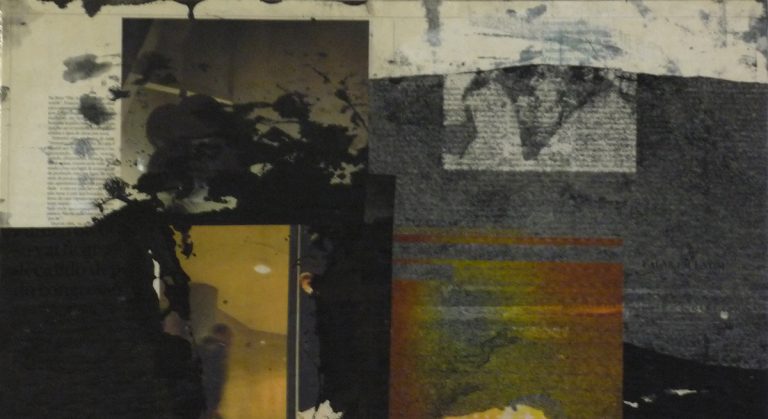José Brito Santos doesn’t paint for decoration. His work isn’t soft-spoken or polished for comfort. Based in Portugal, Brito brings an urgency to his practice that feels more like a confrontation than a quiet observation. His tools are not just brushes and paint—they’re newspaper clippings, thick layers of black ink, slashes of color, and the deep noise of lived experience. You don’t look at one of his paintings so much as fall into it. Each piece is a field of conflict and memory, soaked in contradiction. His surfaces hold residue—of culture, of violence, of dreams unfinished.

His work isn’t clean. It’s layered. It’s loud. And that’s the point. Brito’s paintings resist silence. They insist on being seen and felt. They deal in tensions: chaos and order, darkness and color, silence and sound, matter and myth. For Brito, painting is how the inner world speaks back to the world outside.
José Brito’s paintings don’t start with a finished thought. They begin in the middle of a storm. At the core of his practice is the idea that modern communication—our endless flood of images, noise, and words—is both overwhelming and revealing. Brito gathers from that chaos and builds something new. In his work, black matter isn’t just visual—it’s a state of mind. These areas of shadow on his canvases aren’t emptiness; they are weight. They obscure, but they also challenge the viewer to search for what’s behind.
His use of words—fragments, clippings, hints of something once said—is part of this tension. Sometimes legible, sometimes smeared or partially buried, they push the viewer to piece together meaning in a world that rarely offers full clarity. You’re not handed a message. You have to work for it. In that way, Brito’s art mirrors life.
A quote from Fernando Pessoa sits like a quiet anchor behind much of Brito’s thinking: “I bring into the Universe a new Universe, because I bring into the Universe itself.” That idea of the self birthing something entirely its own feels true in Brito’s practice. The work doesn’t merely reflect reality—it creates its own. His canvases are visual poems. They give form to feeling, to contradiction, to a kind of spiritual noise.
In his exhibition Global Communication (held in Italy), Brito confronted the fragmentation of modern life. But he didn’t try to resolve it. Instead, he leaned in. He painted the conflict between our internal worlds and the external machine of culture. His work recalls Antoní Tàpies in texture and symbolism, and Roland Barthes in the way he treats the image as a myth-making device. Yet, Brito’s language is his own—part dream, part wound, part hymn.
Black dominates many of his works, but it’s not pure black—it shifts. It is soaked with memory, aggression, desire. Around and within these dark masses, flickers of color break through. They don’t conquer the black, but they coexist with it. The black stains are not endings. They are transitions.
There’s something almost spiritual about the way Brito treats the night—not as absence, but as a cradle. He sees night as the place where things are born: longing, gesture, memory, even language itself. It is not just the background for his images but the birthplace of their meaning. His canvases are like dreams you remember halfway—filled with symbols, shapes, and feelings that can’t quite be named but are deeply familiar.
Brito’s work resists easy interpretation. It’s full of paradox. The paintings are broken but whole, silent but screaming, layered with ruin but also beauty. They suggest a world that has been shattered and reassembled. Not fixed—just differently held together. There’s sorrow in this, but also hope. A hope that art, even in pieces, might still carry meaning.
At the center of Brito’s practice is writing—not literal writing, but the idea of inscription. His surfaces are inscribed with thought, dream, and memory. Even when the words are unreadable, their presence carries weight. As if what matters isn’t what they say, but that they once meant something.
In a time of constant communication, Brito paints the opposite. He paints the disconnection, the gaps, the things unsaid. His work aches for contact—not just between people, but between layers of the self, between life and its meaning.
What José Brito Santos offers isn’t comfort. It’s contact. Not a clean message, but a crack through which light and noise and memory flood in. His paintings ask you to slow down, to feel the confusion, and maybe—if you sit with them long enough—to find your own reflection in the mess.


